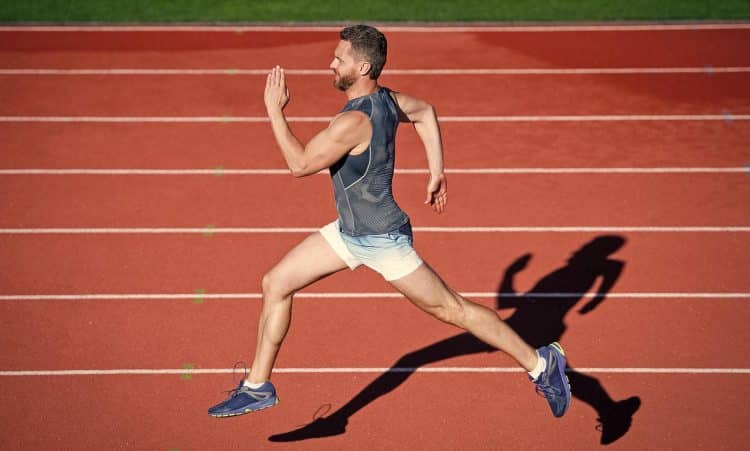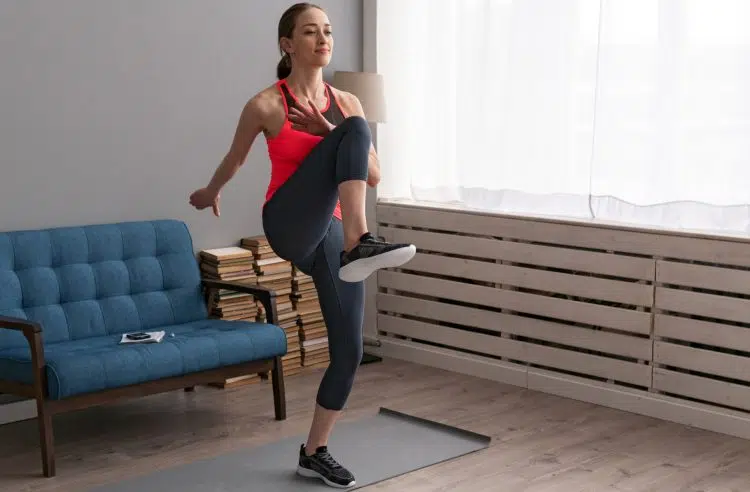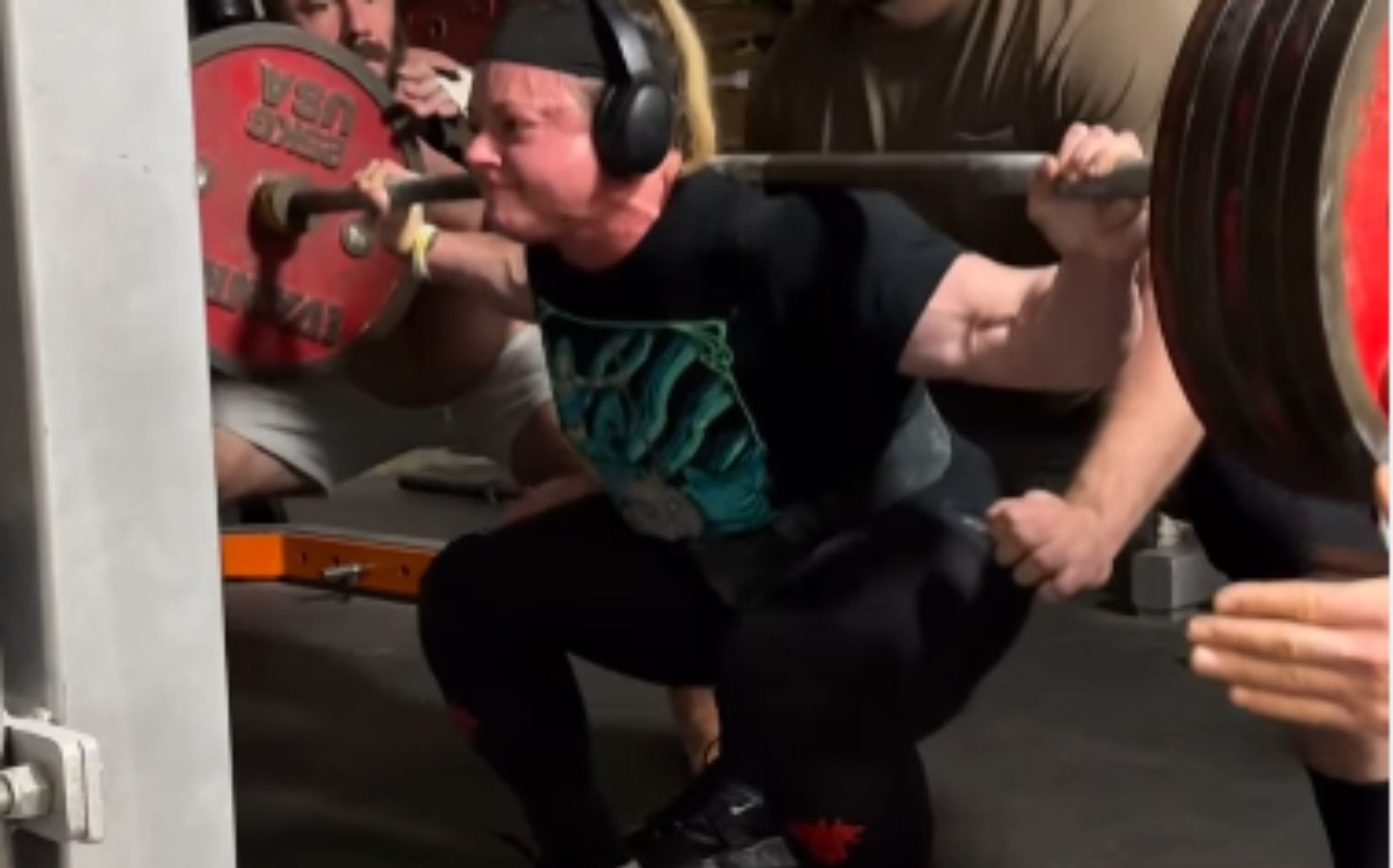Your average stride length in running depends on your height and pace. Generally, it’s 1.1-1.3 times the height for sprinters, 1.14-1.17 times for middle-distance runners, and 0.8-1.1 times for marathoners. Aim for a cadence of 180 steps per minute and adjust stride length to maintain it.
Introduction — Average Stride Length in Running

Picture this: You’re gliding across the asphalt, wind whipping through your hair, legs churning like pistons. Every stride feels powerful, a testament to your training. But then, the insidious question slithers in: “Am I taking big enough steps?”
That, my friends, is the siren song of stride length, a metric both mystifying and misunderstood. For 16 years, I’ve witnessed countless runners fall prey to chasing longer strides like it’s some mythical prize.
But as a personal trainer and self-proclaimed wordsmith, I’m here to tell you the truth: stride length is far from a one-size-fits-all magic bullet.
Think of it this way. While a long stride can eat up miles like a Pac-Man on sugar, it’s often a recipe for disaster.
Level Up Your Fitness: Join our 💪 strong community in Fitness Volt Newsletter. Get daily inspiration, expert-backed workouts, nutrition tips, the latest in strength sports, and the support you need to reach your goals. Subscribe for free!
Overstriding throws your form off-kilter, straining your joints and turning your gait into a Frankensteinian contortion. Efficiency plummets, fatigue sets in, and your dream run devolves into a hobbled nightmare.
A study published in Medicine and Science in Sports and Exercise found that a 10% reduction in stride length can decrease the probability of tibial stress fracture by 3 to 6 percent, while increasing running mileage increases the probability by 4% to 10%. (1)
But fear not, intrepid runners! This article is your compass through the stride-length labyrinth. We’ll debunk the myths, expose the pitfalls, and guide you towards finding your personal goldilocks stride: one that’s neither too long nor too short, just perfectly right for your unique biomechanics and running goals.
Get ready to ditch the dogma and embrace the science. Buckle up because we’re about to embark on a journey that will revolutionize your run, one footbeat at a time.
Read also: Average Human Running Speed (A Runner’s Guide to Outpace the Pack
Understanding Stride Length: The Science Behind Your Steps
Running involves precise choreography — not on a stage, but on the pavement.
At the heart of this rhythm lies stride length, the distance traversed with each footfall. It’s the ruler measuring your progress, but unlike a static tool, it’s a dynamic number between you and the road, constantly influenced by terrain, pace, and even your mood.
Stride length doesn’t operate in a vacuum; it’s always paired with stride rate, the number of steps you take per minute.
Together, they dictate speed and efficiency. A shorter stride with a higher cadence, often the domain of elite runners, can be a recipe for a smooth, energy-saving gait.
Conversely, longer strides with a lower cadence might propel you forward faster but can also increase impact forces and fatigue.
But where do you fit in this dance? Several instruments tune this dynamic duo. Height sets the baseline, with taller runners naturally taking longer strides. Leg length joins the chorus, with long limbs enabling bigger steps.
Don’t be discouraged by these pre-set factors, though. Fitness level is a critical factor; you must constantly refine your technique and optimize your stride for efficiency as you train.
Now, picture your foot landing gently beneath your center of gravity, not far out in front. This minimizes impact and maximizes propulsion, like a well-aimed spear landing squarely on its target.
Your ankle dorsiflexion, the ability to bend your ankle upwards, plays a starring role, acting as a shock absorber and springboard for each step. Imagine it as the flexible hinge that propels your foot forward.
Finding your ideal stride length is less about chasing a specific number and more about determining what feels right.
Experiment with different cadences and stride lengths, feeling how each combination affects your comfort, effort, and speed.
The Numbers Game — Average Stride Length in Running
So, where do you fit in this spectrum of Olympic titans and weekend warriors? Buckle up because it’s not a strict height-to-stride equation.
Imagine two Olympic 800m runners, both devastatingly fast. One might devour the track with 7-foot-9 leaps, while the other conquers it with a rapid-fire 6-foot-4 cadence. Both crush the finish line but with completely different stride lengths.
And don’t think Olympians hold the keys to stride length; marathoners tell a different story. Picture the picture of endurance — a seasoned marathoner gliding through miles with a 6-foot-8 stride, like a metronome ticking off distance with unwavering efficiency.
Marathon runners might lack the explosiveness of their 800m counterparts, but their stride whispers tales of unwavering determination and long-haul prowess.
So, what are the ideal numbers? On average, most runners find a happy medium between 180 and 200 steps per minute (stride rate) and a stride length that’s roughly proportional to their height.
Pro Tip: Consistency is key. Your stride length may naturally adjust as you train, becoming more efficient as your technique improves. Don’t get caught up in chasing rigid numbers; focus on listening to your body and finding what feels right for you.
The Myth of the Universal Stride: Why One Size Doesn’t Fit All
Here are the most common stride length myths you should know about:
1. Shattering the Stopwatch Sirens: Ditch the “Ideal” Stride Length Fantasy
Forget “one size fits all” — that mantra doesn’t belong in your stride playbook.
There’s no magic number, no holy grail of footfalls etched in the running gods’ tablets. The truth? Your perfect stride length is as unique as your thumbprint, shaped by a mix of factors: your height, leg length, running goals, and even terrain.
So, chasing some mythical “ideal” is like chasing shadows — a frustrating, energy-sapping exercise that leads to nothing but burnout.
2. The Two-Faced Coin: Long Strides, Short Strides, and Their Tales
Let’s dissect the double-edged swords of stride length.
Long strides can devour ground like a hungry cheetah, eating up miles with fewer steps. But beware, this efficiency comes at a cost.
Overstriding can wreak havoc on your form, sending shockwaves through your joints and turning your body into a wobbly marionette.
Shorter strides, on the other hand, are champions of control. They’re nimble, quick, and keep your form tight like a well-cinched corset. But their downside? They can sap your energy faster than a sugar rush, especially on long runs.
Level Up Your Fitness: Join our 💪 strong community in Fitness Volt Newsletter. Get daily inspiration, expert-backed workouts, nutrition tips, the latest in strength sports, and the support you need to reach your goals. Subscribe for free!
3. Bodybuilders and Ballerinas: Tailoring Your Stride To Your Temple
Your body type throws its own weight into the stride equation.
For taller runners, longer strides often feel natural. But don’t get seduced by the siren song of length — overdoing it can lead to injuries.
Shorter runners, on the other hand, often find shorter strides feel like home sweet home. This nimbleness can be their superpower, but pushing it too far can drain their fuel tank faster than a hummingbird on overdrive.
4. Goal Diggers: Mapping Your Stride to Your Marathon Dreams
The ultimate destination matters. Are you a sprinter chasing personal bests? Then, longer strides can propel you towards the finish line faster.
But remember, precision is your partner in crime — keep your form sharp to avoid injuries that derail your lightning-bolt journey.
Conversely, marathoners need to be fuel-efficient gazelles. Shorter strides conserve energy, helping you navigate the long, winding road to the finish line without hitting the wall.
5. The Dance of Discovery: Finding Your Groove, Not a Stereotype
So, how do you find your personal stride nirvana? Forget cookie-cutter formulas and listen to your body. Experiment! Play with different lengths on different terrains.
Notice how your body feels and how your energy flows. Does your form stay strong or start to crumble? Does your breath remain steady or turn into a ragged symphony? Trust your own internal metronome, not some stopwatch or pedometer.
6. Remember, Fellow Runners: The Journey is Key, Not the Destination
Don’t get lost in the stride labyrinth.
Remember, it’s not about chasing some mythical “ideal” — it’s about finding a stride that feels good and efficient and empowers you to move with freedom and joy.
In the end, the most beautiful stride is the one that carries you towards a stronger, happier, and more fulfilling you.
Finding Your Perfect Pace: How to Determine Your Optimal Stride Length
Finding your sweet spot is the key to unlocking efficiency, minimizing injuries, and maximizing speed.
As a personal trainer for seven years, I’m here to crack the code on your perfect stride.
1. Ditch the Textbook and Embrace the Tempo
Forget rigid formulas based on height. Your optimal stride is all about your unique biomechanics and running style. Think of it like a fingerprint for your feet, not a number in a dusty textbook.
2. Metronome Magic
Befriend the metronome (yes, that clicky little gadget). Set it to 180 beats per minute, your body’s natural cadence sweet spot.
Run naturally at this tempo, and voila, you’ve got a ballpark for your ideal stride length. Feel like a flamingo?
Adjust the tempo slightly until your stride feels smooth and efficient.
3. Videotaped Truth
Grab a friend or snag a selfie stick — time for some self-scrutiny (the good kind!). Capture yourself running at your comfortable pace.
Slow down playback and take a critical look. Does your heel strike too far out? Do your knees wobble like jelly? Adjust your footfall and stride length based on what you see, aiming for a graceful, balanced stride.
4. Walk Before You Run (Literally)
Before unleashing your inner Usain Bolt, master the art of the power walk. Walk at a brisk pace, focusing on a tall posture, engaged core, and a heel-to-toe strike. This mindful walking translates beautifully into efficient running strides.
5. The Hill Test
Hills aren’t just for suffering (okay, maybe a little). Find a gentle incline and climb it naturally. Notice how your stride shortens? That’s your body’s wisdom at work, adjusting for the increased effort.
Pay attention to this “natural” stride – it’s another clue to your optimal length on flat terrain.
6. Listen to Your Body, Not the Hype
Forget chasing the “perfect” stride length touted by magazines and influencers. Your body is a symphony of unique muscles, tendons, and joints — listen to it to find what works for you. Experiment, adjust, and trust your own biofeedback.
7. Remember, It’s a Journey, Not a Destination
Your optimal stride isn’t set in stone. It evolves with your fitness level, terrain, and even mood. Embrace the journey of discovery, experiment with different lengths, and, most importantly, have fun. Running should be a symphony of joy, not a metronomic march to a prescribed number.
Training Your Stride for Efficiency and Power
Fellow runners, strap on your thinking caps for a masterclass in stride mastery as we crack the code of your gait and unlock explosive efficiency.
No matter your pace or pedigree, refining your stride unlocks a treasure trove of performance gains and injury prevention.
Drill Down for Dynamism:
Add these exercises to your training regimen to improve your stride length:
- High Knees: Ignite your core and fire up your glutes with this deceptively simple gem. March tall, pump those knees skyward and feel the power surge through your legs. Crank out three sets of 30 seconds, and watch your stride shorten and sharpen.
- Butt Kicks: Channel your inner sprinter and chase your heels. This drill strengthens hamstrings and activates those often neglected posterior muscles. Keep your back straight and knees slightly bent, and chase those booties with gusto. Three sets of 20 reps per leg will have your glutes humming with newfound purpose.
- Skipping: Skipping engages numerous muscle groups, improves coordination, and promotes a bouncy, efficient stride. Go high knees on steroids — alternate leg raises with powerful arm swings for three sets of 30 seconds.
Workouts with Wow Factor:
Three workouts for improving stride length:
- Hill Repeats: Conquer inclines and sculpt a steely stride with hill repeats. Find a moderate incline, sprint up with short, powerful strides, and then jog back down to recover. Crank out 6-8 repeats, focusing on maintaining good form throughout. Hill repeats build leg strength, improve oxygen uptake, and transform you into a hill-crushing machine.
- Cadence Drills: Remember, it’s not about how far you fling your legs but how fast they turn over. Practice quick, short strides at a comfortable pace, aiming for 180 steps per minute. Use a metronome or foot pods to track your rhythm. Three sets of five minutes at elevated cadence will ingrain a nimble, efficient gait that devours miles with ease.
- Strength Circuit: Don’t neglect the engine room. Integrate squats, lunges, and calf raises into your routine to build the foundation for a powerful stride. Three sets of 10-12 reps per exercise will strengthen your lower body, improve stability, and propel you forward with newfound vigor.
Check out our Calories Burned Walking calculator to learn how many calories you can burn with a 30-minute walk.
Form Fortress: Your Injury-Prevention Arsenal:
Follow these form tips for optimal performance:
- Head Held High: Resist the urge to hunch. Stay tall, gaze out, and let your neck be an extension of your spine. Good posture aligns your body efficiently, minimizing stress on your back and joints.
- Arms Relaxed: Ditch the T-Rex arms. Keep your elbows bent at 90 degrees, swing them naturally alongside your body, and let your shoulders flow freely. Loose arms promote efficient movement and prevent energy leaks.
- Foot Strike Midfoot: Imagine a ninja silently slinking across the ground. That’s the foot strike we’re chasing — midfoot contact minimizes impact, reducing stress on your knees and ankles. Focus on landing flat-footed, not heel-first, and feel the smooth transition in your stride.
Progress lies not in mindless miles but in deliberate strides toward mastery. By incorporating these drills, workouts, and form tips, you’ll transform your gait from a clunky clopper to a graceful g-force.
Beyond the Basics: Advanced Stride Techniques for Seasoned Striders
Conquered the “cadence-stride dance” and mastered the art of midfoot magic? Hats off, fellow speed demons. But for seasoned runners like yourselves, optimization knows no finish line. Use these techniques to shave seconds off your PRs.
- Hill Drills for Explosive Power: No mountain too high, no valley too steep. Unleash your inner mountain goat with hill drills. Picture bounding uphill like a gazelle, skipping downhill like a playful child, and unleashing powerful high knees on inclines. These drills sculpt leg strength and hone your proprioception, transforming you into a human rocket ready to blast off on any terrain.
- Plyometric Play: Take your stride to new heights with the magic of plyometrics. Think box jumps that defy gravity and single-leg hops that ignite your inner kangaroo. These explosive movements target key muscles, enhancing your ground contact and propelling you further with each powerful push-off.
- The Power of Drills: Even seasoned runners can benefit from dynamic drills like A-skips that unlock hip mobility, and butt kicks that turn wasted energy into pure propulsion. These drills are your secret weapon for mastering a smooth, efficient stride that leaves the competition in the dust.
- Gear Up for Efficiency: Invest in shoes designed for your specific goals. Racing flats for blistering speeds, stability shoes for uneven terrain, and trail shoes for conquering the gnarliest paths. Choosing the right tool for the job optimizes your stride and boosts performance.
Conclusion
Remember, runners, there’s no magic stride number lurking under a rainbow. Your ideal length? It’s as unique as your fingerprint, woven from a tapestry of leg length, cadence, terrain, and goals.
Think of your stride as a personal biomechanical puzzle. Play, tinker, adjust. Does a longer stride leave your knees creaking like rusty gates? Shorten it. Does a choppy step feel like tripping over yourself? Smooth it out. Listen, adapt, and watch your running blossom.
If you have any questions about stride lengths, drop them in the comments below, and I’ll be happy to help!
References
- Edwards, W. B., Taylor, D., Rudolphi, T. J., Gillette, J. C., & Derrick, T. R. (2009). Effects of stride length and running mileage on a probabilistic stress fracture model. Medicine and science in sports and exercise, 41(12), 2177–2184. https://doi.org/10.1249/MSS.0b013e3181a984c4











